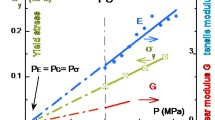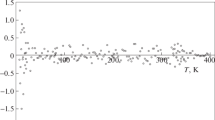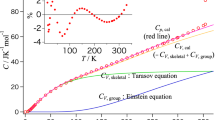Summary
Equation of state data on several amorphous polymers, viz., polystyrene, poly(methyl methacrylate) and poly(vinyl chloride) are considered from two points of view. First in terms of the empiricalTait equation applied to the liquid as well as the glassy state with a single disposable and temperature dependent parameter. These results supersede and extend an earlier analysis. Good agreement between independent investigators is obtained for polystyrene. Secondly, the hole theory ofSimha- Somcynsky is applied to the liquid state of these polymers. The isobar at atmospheric pressure and the compressibility factorpV/T up to pressures of about 2 kbar are analyzed in detail and the numerical values of the characteristic volume (V *), temperature (T *), and pressure (p *) parameters are established. The evaluation of the theoretical expressions requires the numerical solution of a transcendental equation for the hole fraction as a function of the reduced volume and temperature, which arises from the extremum condition on the partition function. At atmospheric pressure, this computation is avoided and the evaluation facilitated by means of a simple and accurate interpolation formula for the theoretical volume-temperature relation. In this manner,V * andT * are readily obtained. A series of theoretical reduced isochores are presented in graphical form, which encompass a change in density of 15% and a temperature range of at least 200 degrees. A single pressure datum then provides an estimate ofp * and thus of the complete equation of state. Finally we note that the reducedTait parameterB, as computed from the theory, exhibits the exponential variation with temperature, observed experimentally.
Zusammenfassung
Die Zustandsgleichung einer Reihe von amorphen Polymeren, nämlich Polystyrol, Polymethylmethacrylat und Polyvinylchlorid wird von zwei verschiedenen Standpunkten untersucht. Zunächst mittels einer empirischen Gleichung vonTait mit einem einzigen willkürlichen und temperaturabhängigen Parameter. Diese wird auf den flüssigen sowie den glasigen Zustand angewendet. Die Ergebnisse ersetzen und erweitern die Resultate einer früheren Untersuchung. Eine befriedigende Übereinstimmung zwischen den experimentellen Werten verschiedener Authoren für Polystyrol wird festgestellt. Sodann wird die Fehlstellentheorie vonSimha- Somcynsky auf den flüssigen Zustand dieser Polymeren angewendet. Die Isobare bei atmospherischem Druck und der KompressibilitätsfaktorpV/T bis zu einem Maximaldruck von ca. 2 kbar werden ausführlich untersucht und die charakteristischen ZustandsparameterV *,T * undp * bestimmt. Die Auswertung der Theorie erfordert die numerische Lösung einer transzendentalen Gleichung für die Löcherzahl als Funktion von reduziertem Volumen und Temperatur, welche aus der Extremalbedingung für das Zustandsintegral folgt. Eine einfache Interpolationsformel stellt die theoretische Isobare für p=1 bar mit großer Genauigkeit dar. Auf diese Weise wird die obige Rechnung vermieden und die praktische Auswertung der Theorie und somit vonV * undT * erleichtert. In graphischer Form wird ein Netz von reduzierten theoretischen Isochoren angegeben, das einer Dichteänderung von 15% und einem Temperaturintervall von 200 °C entspricht. Eine einzelne Druckangabe genügt sodann für eine Abschätzung vonp * und demgemäß der vollständigen Zustandsgleichung. Schließlich wird gezeigt, daß der reduzierteTait Parameter B, mittels der Theorie bestimmt, eine exponentielle Temperaturabhängigkeit aufweist, wie auch experimentell gefunden wird.
Similar content being viewed by others
References
Nanda, V. S. andR. Simha, J. Chem. Phys.,41, 3870 (1964).
Cutler, W. G., R. H. McMickle, W. Webb, andR. W. Schiessler, J. Chem. Phys.,29, 727 (1958).
Hellwege, K. H., W. Knappe, andP. Lehmann, Kolloid-Z. u. Z. Polymere183, 110 (1962).
Prigogine, I., N. Trappeniers andV. Mathot, Discussions Faraday Soc.15, 93 (1953);I. Prigogine, The Molecular Theory of Solutions. (Amsterdam 1957).
Simha, R. andA. J. Havlik, J. Amer. Chem. Soc.86, 197 (1964);Nanda, V. S. andR. Simha, J. Phys. Chem.68, 3158 (1964).
Simha, R. andT. Somcynsky, Macromols2, 342 (1969).
Quach, A. andR. Simha, J. Appl. Phys.42, 4592 (1971).
Wood, L. A. andG. M. Martin, J. Res. Natl. Bur. Stand. (U.S.)68A, 259 (1964).
Nanda, V. S. andR. Simha, J. Chem. Phys.41, 1884 (1964).
Curro, J. G., J. Chem. Phys.56, 5739 (1972).
Jain, S. C. andV. S. Nanda, J. Phys. C: Solid State Phys.4, 3045 (1972).
Quach, A., P. S. Wilson, andR. Simha, unpublished.
Orwoll, R. A. andP. J. Flory, J. Amer. Chem. Soc.89, 6814 (1967).
Simha, R., andR. F. Boyer, J. Chem. Phys.37, 1003 (1962).
Simha, R. andC. E. Weil, J. Macromol. Sci-Phys.B 4 (1), 215 (1970).
Patterson, D. andJ. M. Bardin, Trans. Farad Soc.66, 321 (1970).
Simha, R. andS. T. Hadden, J. Chem. Phys.25, 702 (1956).
Author information
Authors and Affiliations
Rights and permissions
About this article
Cite this article
Simha, R., Wilson, P.S. & Olabisi, O. Pressure-volume-temperature properties of amorphous polymers: empirical and theoretical predictions. Kolloid-Z.u.Z.Polymere 251, 402–408 (1973). https://doi.org/10.1007/BF01498686
Received:
Issue Date:
DOI: https://doi.org/10.1007/BF01498686




